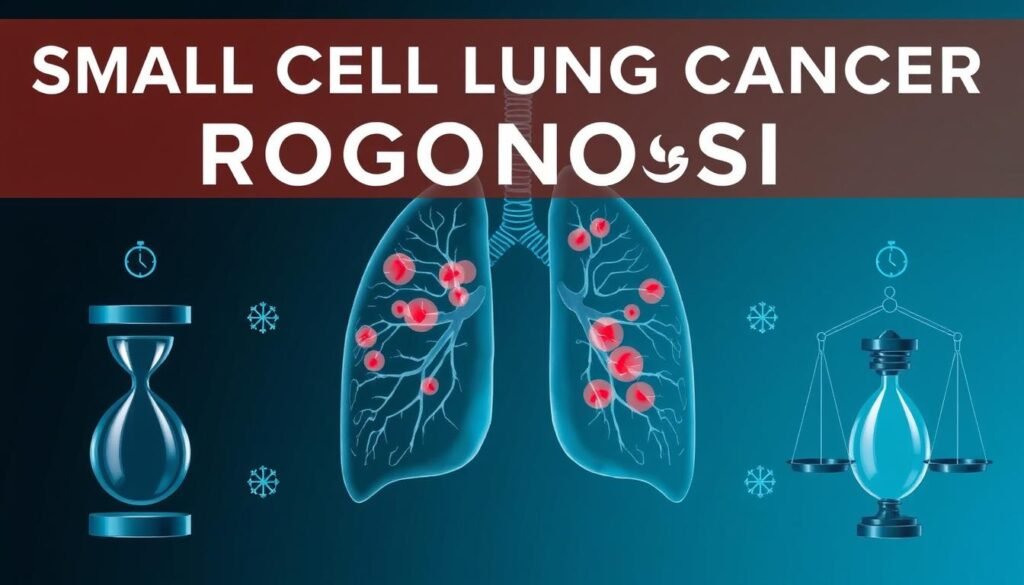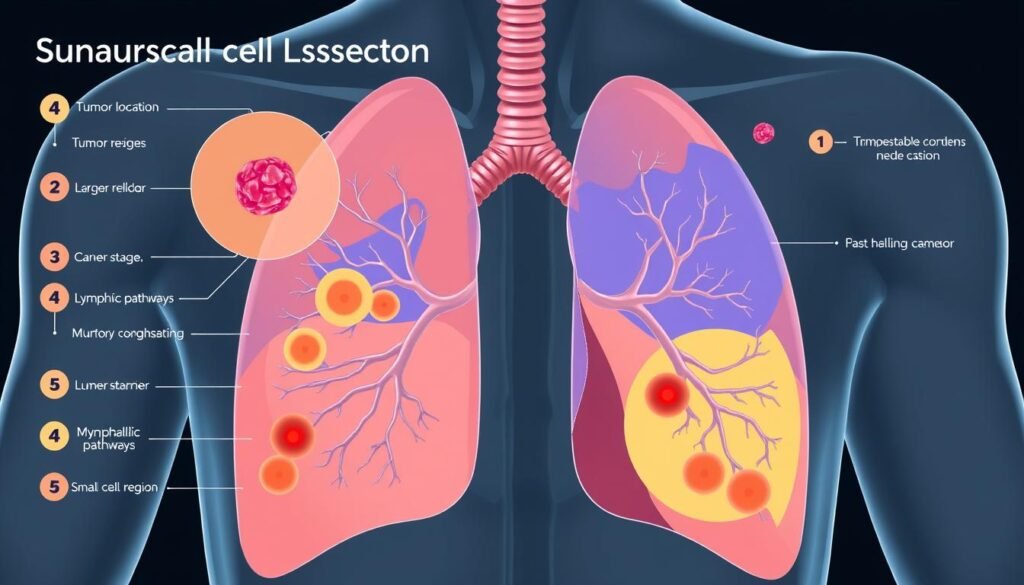Did you know Small Cell Lung Cancer (SCLC) makes up about 15% of all lung cancer cases? This might seem like a small portion, but SCLC’s impact is huge. It’s often found at a late stage and moves quickly. This makes staging small cell lung cancer crucial. Staging shows how far the disease has spread. It guides treatment and helps predict the outcome.
In this guide, we’ll look at how SCLC is staged. We’ll talk about what SCLC is like and how staging shapes treatment and outcomes. Knowing about small cell lung cancer treatment is key to handling the disease. It all starts with understanding how the staging works. For more info, you can visit the staging and treatment guidelines from top health groups.
Key Takeaways
- Small Cell Lung Cancer can be categorized into limited and extensive stages, defining its spread.
- Accurate small cell lung cancer staging is crucial for determining appropriate treatment options.
- The TNM staging system helps inform both prognosis and treatment strategies in lung cancer cases.
- Current guidelines from recognized organizations support the need for comprehensive staging practices.
- Understanding treatment advances can significantly impact small cell lung cancer prognosis and survival rates.
Understanding Small Cell Lung Cancer
Small cell lung cancer (SCLC) starts in neuroendocrine cells of the lungs. It grows quickly and often spreads early. Knowing about SCLC helps understand how it behaves and its treatment options.
Definition and Characteristics of SCLC
SCLC is known for being very aggressive. It usually gets found at a late stage. People with SCLC face big challenges in treatment. This is because it’s often found when it has spread a little or a lot.
Limited stage SCLC means the cancer is in one lung and maybe near lymph nodes. Extensive stage SCLC has spread more widely. Each stage affects how doctors can treat it.
Types of Small Cell Lung Cancer
There are two main types of SCLC. Limited stage has a tumor 4 centimeters or smaller, without spread. Extensive stage means the cancer has moved beyond the lungs, making treatment harder.
For more details on how SCLC is staged, check out more information on staging small cell lung cancer.
The Importance of Accurate Staging
Accurate staging is crucial in managing small cell lung cancer (SCLC). It greatly influences the choice of treatment and affects patient outcomes. By knowing the exact stage, doctors can customize treatments for each SCLC patient.
Impact on Treatment Options
Patients with early-stage SCLC may get chemoradiation, aiming for a cure. On the other hand, those in advanced stages often receive chemotherapy to ease symptoms and extend life. Identifying the stage accurately is key for choosing the best treatment options and ensuring patients receive appropriate care.
Implications for Prognosis
Staging affects more than just treatment choices; it also influences the prognosis of small cell lung cancer. Accurate staging allows doctors to compare with past cases for better outcome predictions. It helps in setting realistic survival expectations and making informed treatment decisions. For deeper understanding, see the importance of multidisciplinary teams in this process here.

Staging Small Cell Lung Cancer
Knowing the stages of small cell lung cancer helps doctors pick the best treatments. They use two main stages: limited and extensive. The limited stage means cancer hasn’t spread far. It’s only in one lung and close lymph nodes. The extensive stage means the cancer has spread to other body parts.
Classification into Limited Stage and Extensive Stage
Distinguishing between the limited and extensive stages is key for understanding the cancer. In North America, 62% of patients first show signs of limited-stage cancer over 25 years. On the other hand, extensive-stage cancer spreads more and is harder to treat. Knowing these stages helps doctors create personalized care plans.
TNM Staging System Overview
The TNM system gives a closer look at cancer’s details. It checks the Tumor (T), Node (N), and Metastasis (M). The T category measures the tumor’s size. It ranges from T1 to T4. For example, T1a means the tumor is small.
The N category tells if lymph nodes are affected. It goes from N0, meaning no spread, to N3, meaning more spread. The M category checks if the cancer has spread further. It’s M0 for no spread and M1 for spread. This system helps doctors be more precise in treatment and prognosis.
Traditional Staging Methods
Knowing the exact stage of small cell lung cancer is key. This helps doctors make the right treatment plan. Traditional methods combine imaging and direct exams to fully check the cancer. These steps help understand how far the cancer has spread.
Imaging Techniques for Diagnosis
Images are crucial for finding small cell lung cancer. The main types include:
- Computed tomography (CT): These scans show the tumor’s shape and place.
- Magnetic resonance imaging (MRI): Helps check if the cancer reached the brain, a common issue.
- Bone scans: Spot cancer in the bones.
- Positron emission tomography (PET): Finds cancer cells by how they act.
Invasive Staging Procedures
Invasive tests confirm the cancer and check lymph nodes. The main methods are:
- Endobronchial ultrasound (EBUS) biopsies: Grabs samples from lymph nodes to help choose treatments.
- Mediastinoscopy: A surgery to see and sample lymph nodes around the lungs for clear staging.
Together, these traditional methods give a full picture of the cancer. This lets doctors plan the best treatment for each person.
Current Guidelines for Staging
Staging small cell lung cancer is key for deciding the best treatment. The National Comprehensive Cancer Network (NCCN) and the American Joint Committee on Cancer (AJCC) have set up important rules. These focus on how to diagnose and plan treatment using scans and biopsy.
NCCN Recommendations
The NCCN shows how crucial correct staging is. It helps achieve better results for patients. They point out that around 30% of cases are in the early stage. Doctors use PET and CT scans to find out the cancer stage. They are urged to stick to these steps for the best care.
AJCC Guidelines
The AJCC emphasizes the TNM system’s role. It’s about categorizing the cancer’s spread. Knowing if the cancer has spread helps with deciding on treatments. Early-stage patients often do better, especially if they get extra chemotherapy. Using both AJCC and NCCN advice can really help patients.
| Guideline Source | Key Focus Areas |
|---|---|
| NCCN Recommendations | Diagnostic imaging, biopsy procedures, staging classification |
| AJCC Guidelines | TNM staging, prognosis, treatment options |
For more details on why correct staging is vital in small cell lung cancer, check out this resource.

Staging and Treatment Options
Knowing the stage of small cell lung cancer helps pick the right treatment. Treatments vary greatly between limited and extensive-stage SCLC. Each stage has specific ways to help patients and ease symptoms.
Combined Chemotherapy and Radiation Therapy
Limited-stage SCLC often uses chemotherapy and radiation therapy together. This method aims to reduce tumors and attack nearby cancer cells. It could cure some patients. These patients might also get treatments like immunotherapy with drugs such as durvalumab if the disease is well-managed after the first treatments.
Palliative Care for Extensive-Stage SCLC
For extensive-stage SCLC, treatment is mainly chemotherapy, often with immunotherapy. The goal here is to better life quality and prolong life, not to cure. Patients might need more chemotherapy or to join clinical trials if the cancer comes back after the first treatment. Radiation therapy may help ease symptoms if the cancer spreads to bones or the brain.

Factors Influencing Small Cell Lung Cancer Prognosis
The outlook for patients with small cell lung cancer depends on several important factors. These include when the cancer is found and the patient’s overall health. Knowing about these factors is key. They help guide treatment choices and possible outcomes.
Stage at Diagnosis
Finding out the stage of the cancer is crucial for predicting the outlook. People found with early-stage SCLC have a median survival of 24 months. This is more hopeful than those diagnosed with advanced-stage SCLC, who have a median survival of just 11 months. People with early-stage SCLC may benefit from treatments like radiation. This can help improve their chances.
Patient’s Overall Health and Response to Treatment
A patient’s health plays a big role in how well they respond to treatment. Those who are in good shape (ECOG 0–1) usually see better results. How well someone responds to the first treatments and certain preventive treatments can also tell a lot about their outlook. Studies show that getting multiple rounds of chemotherapy can lead to longer survival.
Being healthy not just helps with handling treatments. It also means a patient might be able to have surgery. This can greatly increase their chances of survival.
Survival Rates and Statistics
Small cell lung cancer (SCLC) survival rates change with the disease stage at diagnosis. Knowing the disease stage helps make better treatment choices. This knowledge is key for a prognosis in SCLC cases.
Stage-Specific Survival Rates
There’s a big difference in survival rates between the early and late stages of SCLC. The 5-year survival rate for localized SCLC is about 30%. But it drops to 3% for advanced cases. The survival rate for all stages together is just 7%.
Only 33% of SCLC cases are found in the limited stage. The majority are extensive stage. This shows how vital early detection is for survival.
| Stage | Small Cell Lung Cancer Survival Rate |
|---|---|
| Localized | 30% |
| Regional | 18% |
| Distant | 3% |
| All Stages Combined | 7% |
Impact of Treatment Advances on Survival
New treatments like immunotherapy are making a difference in SCLC survival. These options, along with chemo and radiation, offer hope. Patients who stop smoking at diagnosis have a 45% lower risk of dying. This fact highlights the impact of lifestyle on survival rates, too.
Conclusion
The journey through small cell lung cancer (SCLC) shows how important correct staging is. It’s vital for both patients and healthcare pros. Recognizing SCLC’s special traits and what they mean for treatment lets doctors customize plans for each person. Early and right staging is key. It helps pick the best treatment and shapes the outlook for those with this tough type of lung cancer.
About 15% of lung cancers are SCLC, often found in a late stage. This can greatly impact how well patients do. With only a 6% chance of living five years, getting the staging and treatment right is crucial. Doctors are using better scans, like FDG-PET/CT, to find cancer spread and hope to improve future outcomes.
Research and new ways of staging SCLC are very important as we move forward. Healthcare experts are using these new findings to make better choices for care. For more on the role of staging in lung cancer, check out the deep info at effectivehealthcare.ahrq.gov. They provide valuable details on improving diagnosis.